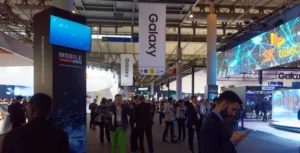 Well, the numbers are in and the 2017 MWC was up 7% on last year in terms of visitors, at 108,000. 2,300 companies were there as exhibitors. Organisers said that 55% of attendees held senior-level positions, including more than 6,100 CEOs (which could be related to the €800 cost to walk the show floor!). There were 3,500 media staff and industry analysts. The area was 115,000 m2 at the main event and there was 50,000 m2 at the Montjuic 4YFN and YoMo events.
Well, the numbers are in and the 2017 MWC was up 7% on last year in terms of visitors, at 108,000. 2,300 companies were there as exhibitors. Organisers said that 55% of attendees held senior-level positions, including more than 6,100 CEOs (which could be related to the €800 cost to walk the show floor!). There were 3,500 media staff and industry analysts. The area was 115,000 m2 at the main event and there was 50,000 m2 at the Montjuic 4YFN and YoMo events.
So, according to the numbers, the show was a success. The ‘elephants in the room’ were that the two biggest handset suppliers, Apple (which doesn’t have a booth at the show at all) and Samsung, did not show new handsets, although both are expected to. Apple follows its own timetable, but delays for extra enginering and testing of the S8 following the Note 7 problems meant that it will be launched at a Samsung event in New York on March 29th.
In terms of handsets, it was dull, with few innovations. The new G6 from LG is certainly competent and its support of Dolby Vision in its display is good news. Sony also added HDR to its new UltraHD handset. The UltraHD Alliance announced its new specification for HDR, although neither of the two HDR phones at the show can carry the label as it seems to mandate an OLED display and they are in short supply. There were lots and lots of 5″ to 6″ Android handsets that were all very similar. Most of the differentiation is in battery size and camera. The selfie camera in several phones is now as good or better than the ‘main’ or rear one.
That the ‘re-launch’ of the Nokia 3310 could be one of the hot topics at the show really says all you need to know about the excitement in handsets.
Chinese brands were very much in evidence, but Taiwanese brands were missing – there was no Acer, Asus and HTC seemed as interested in the Vive as it was in its smartphones. Given their shrinking share and shift to other areas, their absence is not really surprising.
VR headsets were in abundance, including a number of Microsoft Hololens demonstrations. However, there was little that seemed new to us. We were, once again, impressed by the Vuzix and ODG image quality. There is also a lot going on in 360 degree video and we were impressed with a demo application of 360 degree sports video that used gaze to show close ups and statistics in a very natural way.
However, MWC is not just about the handsets, it’s where the operators and the infrastructure companies meet and they were very, very strong in pushing 5G as the ‘next big thing’ to drive technology and the market. Although mobile specifications are not yet finalised, the high bandwidth and low latency are already opening up potential new applications. The IoT was also a topic, and will need 5G, but we didn’t spend a huge amount of time on that.
Next year’s MWC will take place from February 26th to 1st March, in Barcelona again. Barcelona in February is, after all, one of the attractions! (BR)

